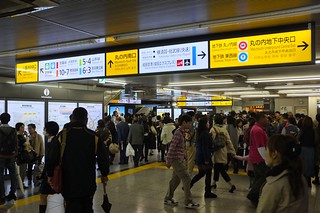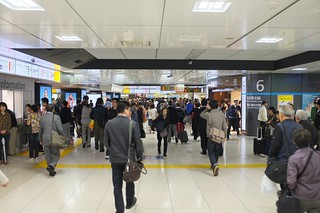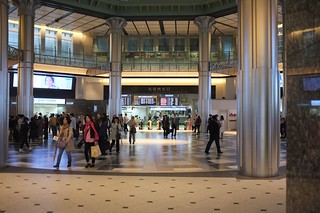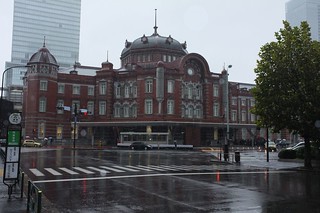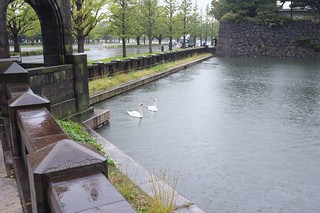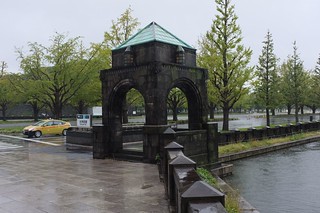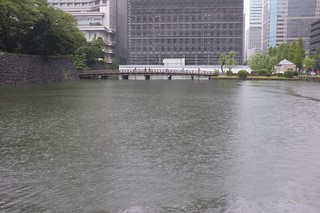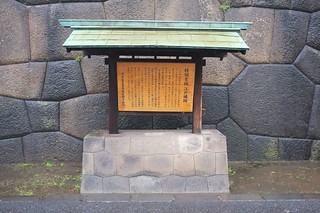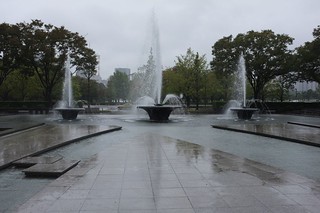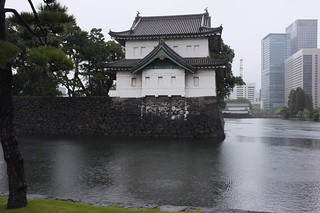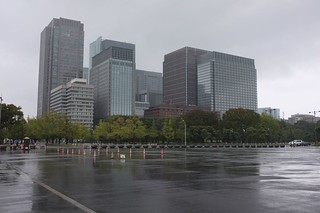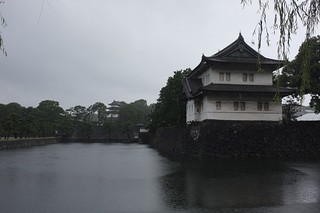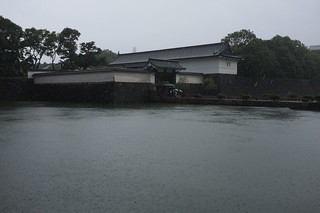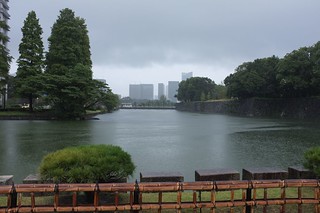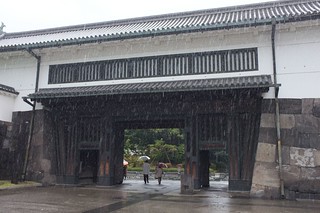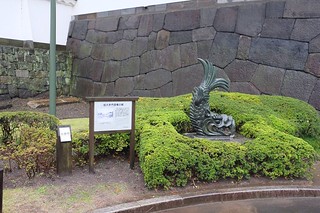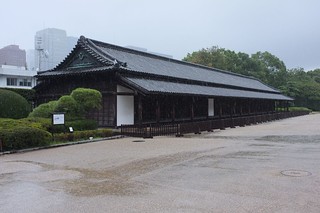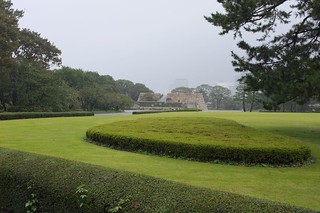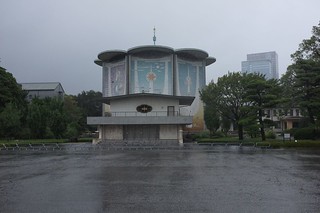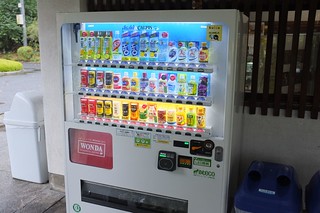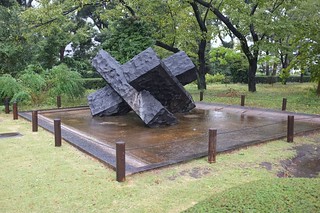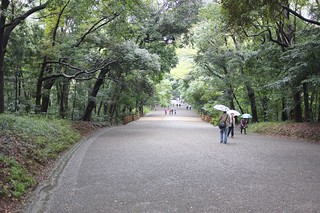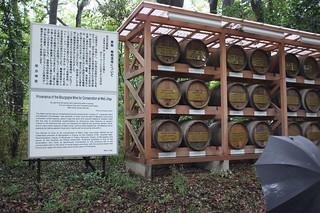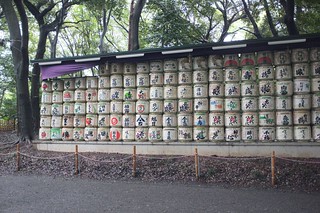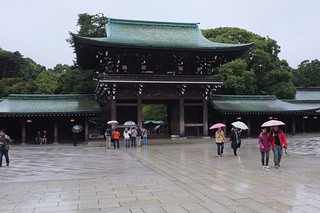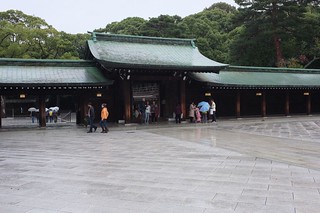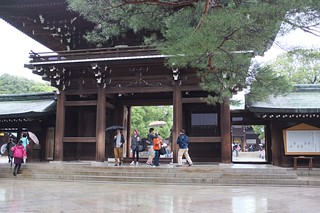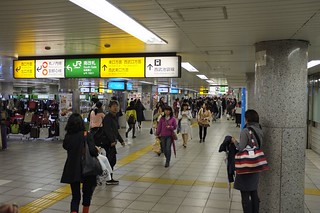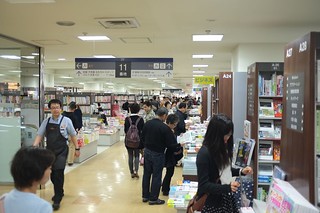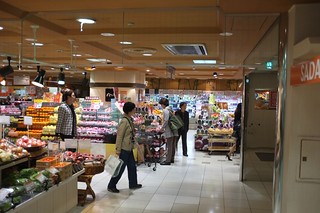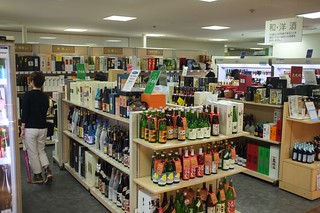Day 2: Exploring Tokyo
Today’s plan was to adjust to the time change and start exploring Tokyo. It turns out dealing with the time change isn’t too bad so far — going west is easier than going east. A pity I always have to go east when traveling for business. Having gone to sleep around 9 p.m., I woke up around 4 a.m. (which would have been around noon my body time) and couldn’t really fall back asleep. So around 5 a.m. I got my computer for a bit, but then was actually able to get a bit more sleep until my alarm went off at 8 a.m.
The hotel fee includes free breakfast, and it turns out that the breakfast is from a Denny’s that is here in the building. Yes, I know, my first meal in Japan was from Denny’s. But except for the sign on the door, you wouldn’t recognize it as a Denny’s. The menu had pictures so I could just point to what I wanted to order: a fried-egg, lettuce, and ham sandwich with tea. Tomorrow morning I have my sights set on another option that appears to be a more traditional Japanese breakfast.
After breakfast, it was off to explore.
Weather update
Today was a rainy, windy day in Tokyo. And we’re not talking Portland-style rain, we’re talking pouring rain most of the day and frequent strong gusts of wind. My first purchase in Japan: an umbrella. The convenience store at the hotel/train station sells them so I didn’t even have to go out in the rain to get one. The native Oregonian in me feels a bit dirty using an umbrella, but it is really the only sane option.
With that out of the way, I figured a good starting point would be to make my way back to Tokyo Station and look around there for a bit. So I hopped on the Yamanote line train back to Tokyo Station.
Tokyo Station is massive, and there are multiple levels with train platforms. I pretty much wandered around aimlessly with no particular mission. After a little while I decided while I was there to make my train reservation for my trip to Nagano tomorrow evening, so found a travel service center. It turns out the one I went to could only make reservations for same-day trains, but they directed me to one of the reservation offices elsewhere in the station that can make future reservations. So far everyone I’ve talked to in the Japan Rail offices have spoken English.
With tomorrow’s transportation taken care of, I wandered around the station some more. It was approaching lunch time, and I ended up happening upon “Kitchen Street,” which has tons of little restaurants. After perusing the options I picked one out, appreciating the fact that they had an English menu on display (all of the restaurants have pictures menus, so it’s not critical for the text to be in English).
Note that horse meat (raw horse meat, that is) is on the menu. I opted instead for ramen with pork and dumplings.
The restaurant was small, with a few tables for groups but most people were sitting at a bar around the kitchen.
Friendly locals
After sitting down and ordering, a Japanese woman sitting next to me who was finishing up and about to leave asked me, in perfect English, if this was my first time here and a little about my trip, and wished me well. After she left, my dumplings came. On the other side of me was an older man, and when I started eating the dumplings he was apparently concerned that I hadn’t put soy sauce on them. He pushed over a bottle of soy sauce and said, “this is for that,” pointing at my dumplings. I thanked him and poured some in the well on the plate for it and proceeded to dip my remaining dumplings in it when I ate them. He also asked if I was good with chopsticks, and I said I’m okay, and he said, “just in case, those [pointing to a stack of paper bibs] are if you’re not sure.” I knew that I was competent enough not to drop a dumpling on my lap, but the bibs were actually quite handy for the ramen as eating ramen with chopsticks can tend to splash the broth on you (which is why the bibs are there and most of the people in the restaurant were using them). In any case, I thought it was really nice how helpful the old guy was trying to be.
With that, it was time to leave the station and see what Tokyo had to offer. This was the first time I’d seen the actual ground floor lobby and exterior of the station.
I knew the main attraction from Tokyo Station was the Imperial Palace. And the good news is if you take the right exit out of the station, the road goes straight to it so I had high confidence I’d be able to find it and find my way back to the station. You can’t really see the palace itself but down the road are the Imperial Palace East Gardens, which are open to the public.
On the walk to the palace area I saw some geese, some sort of street corner shelter thing, a sign I couldn’t read, and a neat park with fountains and such across the street from the palace grounds.
This is what I could see of the palace grounds, and a view of some buildings looking back toward where I came from.
Then to the Imperial Gardens. I’m guessing the vending machine isn’t part of the historical significance.
As you can see from the pictures, the weather was pretty consistently nasty.
Yamanote line
Walk back to the station, and then try to find the Yamanote line platform again. The Yamanote line makes a circle around Tokyo, with one train going clockwise and another going counter-clockwise. The trains come every couple minutes, so it’s never a long wait. So far when I’ve ridden the train it’s been anywhere from nearly empty to you’re-standing-and-touching-the-people-around-you. Note that I’ve only been on the train Saturday night and throughout the day Sunday; I’m assuming rush hour is a whole new level of packed.
My plan today was to check out a couple of the stops to see different parts of Tokyo.
First stop, Harajuku. Supposedly Sunday afternoon is when all of the cosplay fans descend on the area, but I didn’t see any. Either the rain kept them away or the info in my book was outdated. In any case, Harajuku is also where the best-known shrine in Tokyo is. The Meiji Jingu shrine enshrines Emperor Meiji and his consort Empress Shoken.
The area around the shrine is a huge piece of forested land (a couple hundred acres I think). It’s a reasonably long walk from the street along the gravel path to the shrine complex itself. Along the path are barrels of wine from France and straw-wrapped sake barrels. And more signs I can’t read.
At the end of the path you get to the outer area of the shrine. There’s a part in the middle where photography isn’t allowed, but you get the idea from the outer parts.
Then I walked back to the station, hopped back on a Yamanote line train, and got off at Ikebukuro, which is where two massive department stores are. The station itself is pretty large and is a shopping center in its own right.
And outside:
I checked out one of the two department stores, Tobu. It’s massive and as far as I can tell has a department for anything you might ever want to buy. The store proper is eight floors (and the floors themselves are large), and two more basement floors for a food court and grocery store. Just figuring out how to navigate the place took a while, but I eventually found an English floor guide at the top of the sixth floor escalator.
Here’s the books section, on the seventh floor:
I’m pretty sure the books section of Tobu is on par with the Barnes & Noble by my house. And back down at the lower levels, the groceries and liquor:
Day wrap up
At this point I was pretty much at my limit for walking around and being touristy, so I hopped back on the Yamanote line headed for Komagome and settled in for the evening. I had planned on heading back out for dinner after resting a bit, but haven’t become particularly hungry yet (probably still adjusting to the time) so I may just wait for an early breakfast tomorrow morning.
Tomorrow I need to check out of the hotel at 11, and am taking the train to Nagano at 5:45 p.m., so I’ll have several hours to check out more stops on the Yamanote line.
Random notes
All of the money has Arabic numerals except the 5 yen coin. I had to Google to see the value of that one.
Everything here talks to you and plays melodies. Elevators talk to you, ATMs talk to you, etc. I don’t know what they’re saying (except thank you), but they’re certainly saying a lot. The train stations are always playing little melodies as trains come and go. Some are consistent across stations, but then sometimes you hear one that is different before the common one plays. I’m sure there’s some meaning to it all, but I don’t know what it is.
All of the service staff is very polite, in a formal sort of style. The first example was on the train yesterday from the airport to Tokyo. The fare inspector (or at least that’s what I’m assuming he was… he didn’t actually check tickets, but since it’s a reservation-only train and the reservation system is computerized, I think he was looking at his handheld computer and making sure that all of the seats the had people in them had a corresponding reservation in the system) went to the front of the train car, faced all of the passengers and bowed, then walked through the car checking his computer, then walked back to the front of the car to go to the next car but before leaving turned back and bowed again. Waiters in restaurants say a lot to me which I don’t understand, but can tell is more of a formal protocol and not just ‘hey, here’s your food’ like in American restaurants.
Everything is clean and well maintained. There’s no vandalism that I’ve seen. Portland’s a pretty good city as far as these things go, but the MAX train windows are always scratched and stuff is etched into the seats from time to time. Other cities I’ve ridden mass transit in have more of that kind of stuff. Not so here so far — the Yamanote line has significantly higher ridership than MAX ever will, yet doesn’t appear to have the cosmetic blemishes to make you think it.
It is a little strange to be constantly surrounded by a language I don’t understand. Ordering in restaurants by pointing at the menu works, but having the waiter saying all sorts of stuff to me that I don’t understand is weird, as is the fact that I’m always overhearing people around me talking but have no idea what they’re saying.
With that said, Tokyo (at least around the train stations, which is all I've seen) is very accessible for foreign—particular English-speaking—visitors. All of the important information related to the trains is in English (on directional signs, most station maps, the displays in the trains themselves, etc.) and a lot of the other signage (at the Imperial Garden and the shrine, for example) has English translations. The English is often that unique Japanese style of English, but I definitely appreciate it.
Before I left, people pointed out that I’d be a really tall guy looking out over a sea of shorter people and wondered what that’d be like. Walking around I really haven’t felt any different in that regard than at home: I’m well above average height at home, so aside from the fact that it’s less often I see someone my height here, I’m so used to being taller than almost everyone that I don’t notice a difference here.
